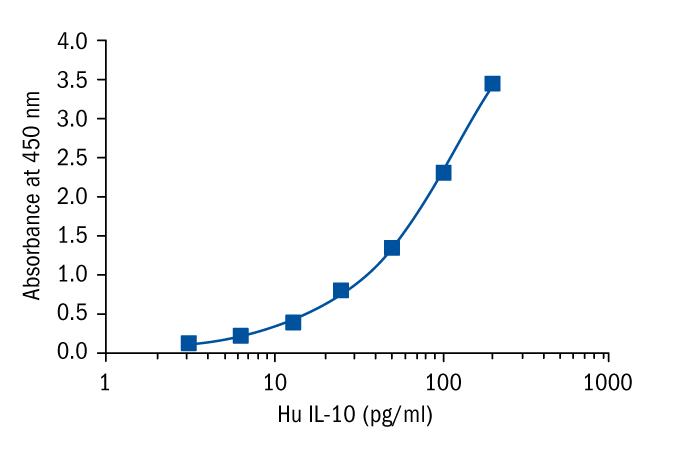Type
Sandwich ELISA, Biotin-labelled antibody
Applications
Serum, Plasma
Shipping
At ambient temperature. Upon receipt, store the product at the temperature recommended below.
Storage/Expiration
Store the complete kit at 2–8°C. Under these conditions, the kit is stable until the expiration date (see label on the box).
Calibration Curve
Calibration Range
3.13 – 200 pg/ml
Limit of Detection
1.32 pg/ml
Intra-assay (Within-Run)
n = 8; CV = 1.9%
Inter-assay (Run-to-Run)
n = 6; CV = 4.2%
Spiking Recovery
102.9%
Dilution Linearity
97.0%
Features
- It is intended for research use only
- The total assay time is less than 3.5 hours
- The kit measures IL-10 protein in human serum and plasma (EDTA, citrate, heparin)
- Assay format is 96 wells
- Standard is recombinant protein based
- Components of the kit are provided ready to use, concentrated or lyophilized
Research topic
Cytokines and chemokines and related molecules
Summary
Interleukin-10 (IL-10) is a Type II cytokine and the “founding” member of a family of cytokines. IL-10 is an important anti-inflammatory and immunosuppressive cytokine.
IL-10 is a homodimer with molecular mass of 37 kDa consisting of 160 amino acid monomers.
Important producers of IL-10 are T-helper type 2 (Th2) cells, subset of regulatory T cells designated Tr1, Th1 and Th17 cells, CD8+ T cells, monocytes, macrophages, certain subsets of dendritic cells (DCs), granulocytes including eosinophils and mast cells. Non-immune cells producing IL-10 include keratinocytes, epithelial cells and even tumor cells. Expression of IL-10 in unstimulated tissues is negligible and seems to require triggering by commensal or pathogenic flora.
The primary function of IL-10 is to down-regulate immune response and limit tissue damage.
IL-10 can strongly inhibit secretion of IL-2/INF-γ by Th1 cells, IL-1, IL-6, IL-12, and tumor necrosis factor α in macrophages and dendritic cells in order to reduce tissue damage. IL-10 may be increased by transforming growth factor β (TGFβ), interferon α (IFNα), IFNβ and histamine.
IL-10 plays a crucial role in neuronal homeostasis and cell survival. IL-10 plays a protective role in microglial cultures after a pro-inflammatory insult and in rat pups born to dams infected with Escherichia coli. However, several studies have questioned the perception of IL-10 solely as an immunosuppressive cytokine because it can also stimulate immune responses by promoting the proliferation and cytotoxic activity of natural killer cells and CD8+ T-cells as well as the survival, proliferation, differentiation, MHC class II expression and antibody production of B-cells.
IL-10 plays a pivotal role during the chronic/latent stage of pulmonary tuberculosis. IL-10 is found in serum, plasma and bronchoalveolar lavage fluid of active tuberculosis patients.
Increased levels of IL-10 secreted from macrophages have also been associated with certain types of cancer including prostate, breast, cervical and gastric tumors.
Since IL-10-mediated immune responses are quite important in maintaining intestinal homeostasis and commensal flora tolerance, it has been suggested that an aberration n IL-10 production may be involved in pathogenesis of Crohn´s disease and ulcerative colitis.
Other autoimmune diseases, such as systemic lupus erythematosus, type 1 diabetes mellitus, psoriasis, and rheumatoid arthritis, have also been shown to be associated with IL-10.
Find documents for the lot
Example Instructions for Use (RUO)
Example Instructions for Use (RUO)
Safety Information (RUO)
MSDS (RUO)
MSDS (RUO)
MSDS (RUO)
MSDS (RUO)

